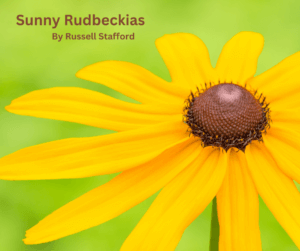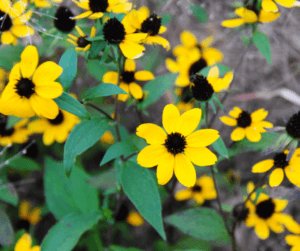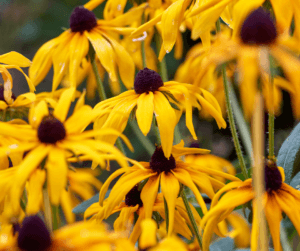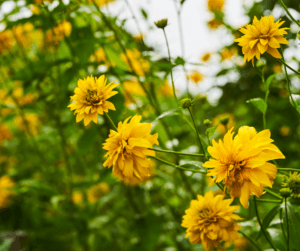
Rudbeckias are as American as the Fourth of July. All 20-something species of this sunny-flowered genus call North America home, with most occurring in at least part of the U.S. A familiar sight in meadows, prairies, and gardens, they are commonly known as black-eyed susans or coneflowers – names that allude to the dark-hued central disk that typifies their blossoms. The petals that radiate from this “cone” are usually a bracing bright yellow. The flowers typically continue for many weeks beginning in June or July, starring in the summer (and fall) border. If you want perennials and annuals with a cheerful disposition and prolific summer-long flowers, rudbeckias top the list. For even more prolific bloom, give them a spring topdressing of Fafard® Garden Manure Blend.
They are also easy keepers. Most Rudbeckia (including the following) accept a wide range of soil types, tolerate drought, and resist pests and diseases, with rabbits and deer often sparing their raspy foliage. Their only universal need is abundant sunlight. They do and look well combined with other sun-loving meadow and prairie perennials such as switchgrass (Panicum virgatum) and blazing stars (Liatris spp.).
Black-eyed Susan (Rudbeckia hirta)
This eastern North American native lifts archetypal gold-petalled, black-coned flowers on 2- to 3-foot stems from late spring until frost, above rosettes of furry tongue-shaped leaves. Numerous garden forms are available, including so-called Gloriosa Daisy types, with especially large blooms that are often heavily stained with maroon. Named cultivars include ‘Cherokee Sunset’, whose huge double blooms carry various shades of burgundy and orange; ‘Prairie Sun’, with yellow, amber-haloed, green-coned blossoms; and ‘Indian Summer’, an enormous golden-yellow form. Compact forms such as ‘Toto’ and ‘Rustic Dwarfs’ fit nicely where space is more limited (including containers). All forms tend to be short-lived, in most cases behaving as biennials or annuals.

Brown-eyed Susan (Rudbeckia triloba)
Also short-lived, this relatively little-known biennial or perennial from central and eastern North America makes a highly rewarding and colorful garden subject in USDA zones 3 to 9. Borne from summer through fall in many-flowered clusters, the blooms resemble miniature black-eyed susans. Some forms such as ‘Prairie Glow’ have red-marked flowers reminiscent of Gloriosa Daisy forms of Rudbeckia hirta. Both of these short-lived species possess exceptional drought tolerance and self-sow freely if allowed.

Orange coneflower (Rudbeckia fulgida)
Most familiar in the form of cultivar ‘Goldsturm’, orange coneflower spreads by underground rhizomes and by seed to eventually occupy large swaths of garden. Many ‘Goldsturm’ in cultivation are actually imposters, with rangier stems and smaller flowers than the 2-foot-tall original. Whatever the variety, orange coneflowers produce gold-petalled, brown-coned blooms from July until frost, attracting loads of pollinators along the way. Dwarf selections such as foot-tall ‘City Garden’ and 15-inch ‘Little Goldstar’ work well in tighter spaces. All forms of this eastern North American native thrive in moist well-drained soil, but also do fine in drier sites. Winter hardiness is from USDA zones 3-9. Sweet coneflower (Rudbeckia subtomentosa) gives the effect of a somewhat taller, lankier, non-running Rudbeckia fulgida, with pure yellow rather than orange-yellow petals. The petals are furled into funnels in the cultivar ‘Henry Eilers’, lending it a novel look. Missouri coneflower (Rudbeckia missouriensis) also bears a summer-through-fall bounty of yellow, dark-coned blooms on clumping rather than spreading plants. The densely hairy, relatively slender-leaved, highly drought-tolerant plants top out at around 30 inches and do best in zones 4 to 9.

Cutleaf coneflower (Rudbeckia laciniata)
Here is the rudbeckia to grow if you want to make an architectural statement. Large eye-catching expanses of bold deeply cleft leaves bring forth towering stems crowned with yellow-petalled, green-coned blooms. The young leaves make good eating in stir-fries and other dishes. Flowering occurs from late summer into fall. Plants can spread vigorously underground, so either give them plenty of room or choose a less rambunctious selection or hybrid such as ‘Herbstsonne’. The double-flowered cultivar ‘Goldquelle’ is also relatively well behaved, especially compared to ‘Hortensia’, a rampant double-flowered selection that often goes under the name ‘Golden Glow’. This adaptable species from eastern and central North America does well in USDA zones 3 to 9. Also quite architectural is the south-central U.S. native commonly known as great coneflower, (Rudbeckia maxima). Drawing considerable attention in spring with its immense gray-green cabbage-like basal leaves, it produces flowers with prominent thimble-shaped cones on near-naked 5-foot-plus stems in summer and fall. Happiest in relatively moist, humus-rich soil, it sometimes fails for no discernible reason, even well within its zone 5 to 9 hardiness range.

